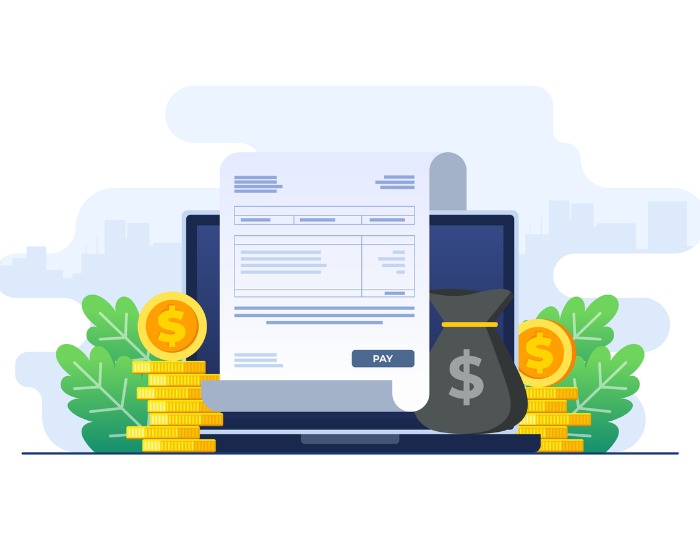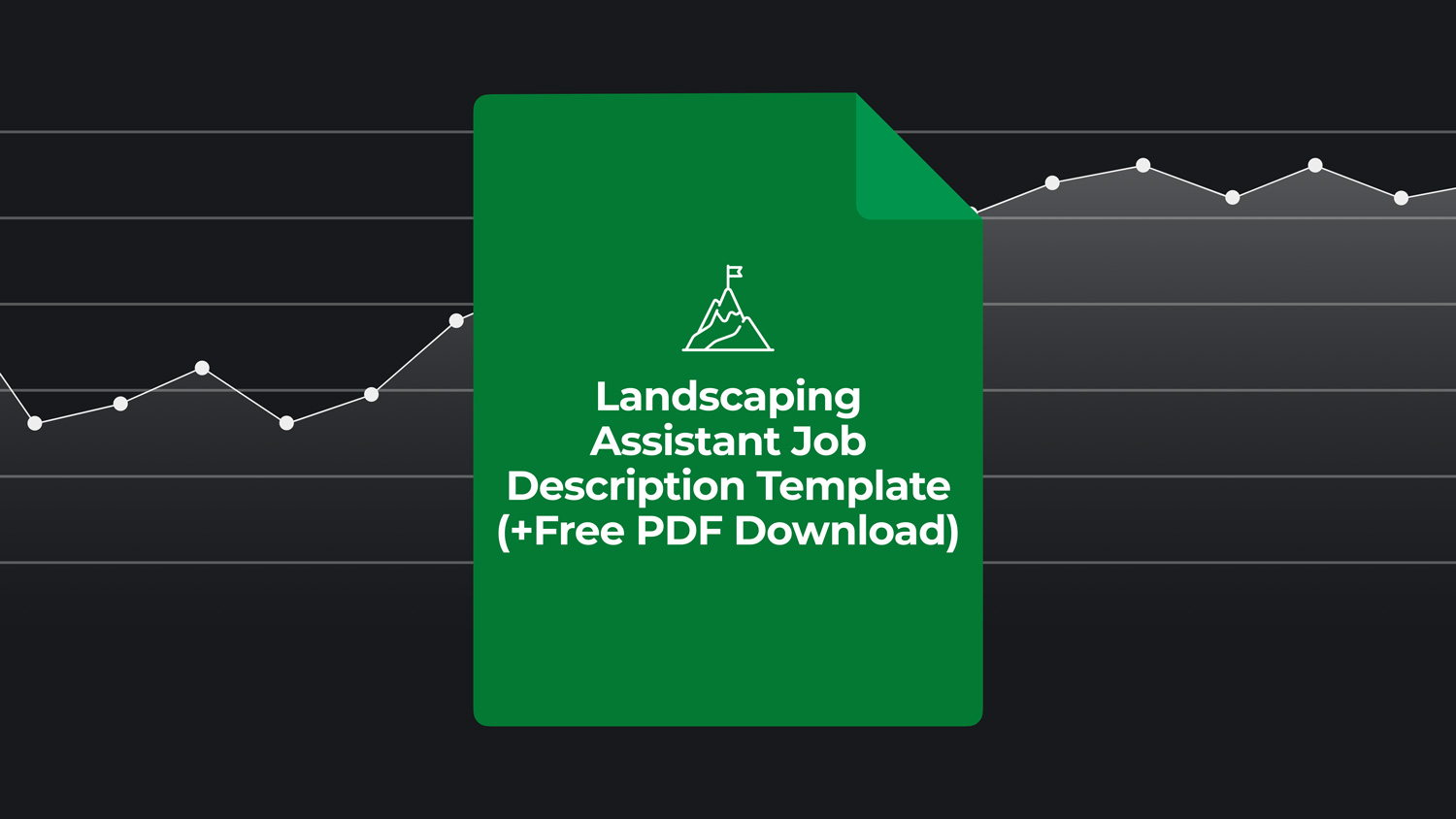Table of Contents
Table of Contents
A commercial cleaning business plan can kickstart a new endeavor or clear the way for growth for an existing enterprise.
Crafting a comprehensive commercial cleaning business plan is pivotal to starting a new venture or fostering significant growth in an existing service. A well-structured business plan becomes a cornerstone for:
Making informed decisions
Setting objectives
Navigating the competitive commercial cleaning market
A cleaning company business plan isn’t a one-and-done task. You should regularly review and revise your business plan to evolve as your company grows to reflect your current vision, market, and financial targets.
This template provides a sample to help create a business plan.
Executive summary: Setting the foundation
An executive summary is an overview of your entire business plan.
While the executive summary is the first section of a business plan, most business owners find it makes sense to write it last. The executive summary often is one to two pages, but you should keep it as short as possible.
Essential components of an executive summary include:
Mission statement: Defines your company's mission, vision, and core values.
Company overview: Write a company description of services, locations, and number of cleaning staff. Include a short history of how the business started, names of owners, and business growth milestones.
Market synopsis: Provide an overview of your market, mentioning your commercial cleaning business's size and competitive advantages.
Financial elements: Summarize your business financials, including sales, profits, and projections for one to two years.
Future objectives: Outline your company’s plans for growth, such as offering new services, adding verticals, or expanding your service area.
Your executive summary must be clear and concise. If you’re seeking funding for your small business, the executive summary should demonstrate your cleaning company’s value to potential investors.
Industry analysis: Understanding the market landscape
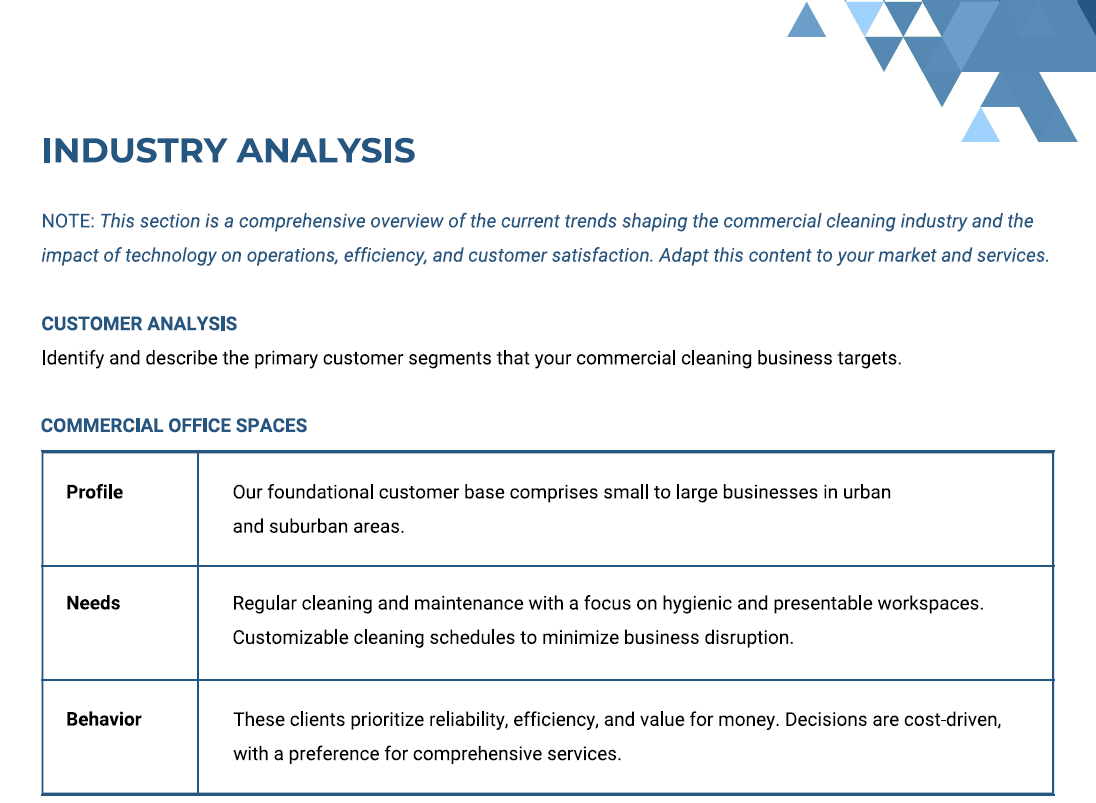
An industry analysis identifies the potential market for your commercial cleaning or janitorial services. This involves defining and comprehending key elements such as:
Target customers
Competition
Cleaning industry trends
Customer’s changing demands
Customer analysis
Commercial cleaning companies perform a customer analysis to understand and meet customer needs. This research-based process identifies your potential client base's demographics, values, and behaviors.
To perform a customer analysis:
Gather information about your target market through your existing customer data, industry research, online tools such as Google Analytics, and social media surveys.
Segment your customers based on similar demographics, traits, preferences, and pain points.
Create customer personas, or fictional profiles, of your target customers and their specific needs.
Leverage your customer analysis to inform business services, products, and prices.
Customer relationship management (CRM) software assists market analysis by providing invaluable information about your customers and their buying journeys.
→ Aspire commercial cleaning business software helps businesses connect the dots with real-time customer data, feedback, and analysis.
CRM data empowers companies to retain existing customers and expand their customer base by cultivating strong relationships with prospects and customers through:
Efficient communication
Personalized offers
Proactive support to address potential issues before they escalate
Competitor analysis
A competitive analysis identifies the competitors in your market. It helps you understand market demand and gives your business a competitive edge.
For instance, if you plan to specialize in carpet cleaning or window cleaning, you’ll want to know if competitors offer these services and what they charge.
Steps to perform a competitor analysis include:
Identify and gather information about your competitors.
Evaluate competitors’ services, service areas, prices, promotions, reputation, sales tactics, marketing strategies, target audience, and online presence.
Analyze the strengths and weaknesses of your business.
Develop sales, marketing, and pricing strategies to gain a competitive advantage.
Once you know your customers and competitors, these assessments will help you develop effective marketing campaigns.
Marketing plan: Promoting your cleaning services
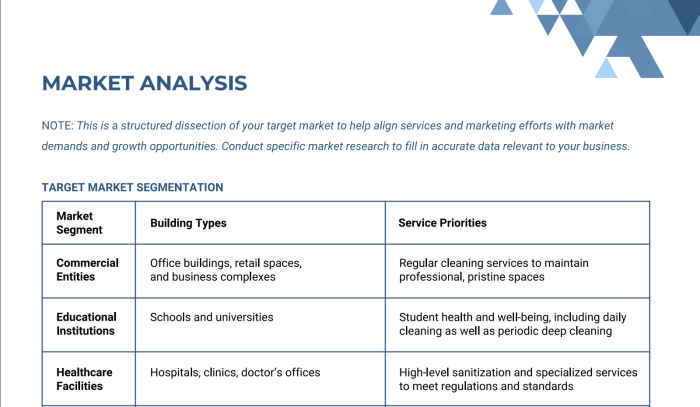
While a service business plan template provides a guideline for developing a marketing plan, it’s crucial to identify your company’s marketing goals and include methods to measure outcomes.
An effective marketing plan includes the following components:
Market research: Know your audience, their preferences, and their preferred online channels.
Marketing objectives: What do you want to accomplish? Increase cleaning contracts? Generate leads? The more specific your objectives, the better.
Marketing strategies: The marketing channels you use depend on your target audience. The most effective marketing campaigns use an omnichannel approach to share a consistent message online and offline.
Pricing strategy: A cleaning service pricing strategy should cover costs and include an appropriate profit margin. Your target market preferences and competitor pricing should also be factored into your pricing strategy.
Marketing budget: Determine the percentage of revenue for your marketing budget. Focus on the channels that deliver the best return on investment (ROI). You can adjust your budget depending on objectives, channels, and results.
Key performance indicators (KPIs): Measure marketing effectiveness with KPIs. These could include conversion rate, customer acquisition cost, cost per lead, customer lifetime value, and overall ROI. Track KPIs to make better marketing decisions and improve your ROI.
Review your marketing plan annually. Some businesses review their marketing strategy and budget quarterly to adjust as needed.
Financial plan: Estimating costs and projections
A solid financial plan ensures your commercial cleaning business doesn’t just stay afloat but thrives.
To get funding for business operations, you’ll need a realistic estimate of:
Initial startup costs
Ongoing operational expenses
Financial projections
A comprehensive, realistic financial plan shows potential partners and investors the value of your company and outlines business growth.
→ Include graphs and visuals in your financial plan to break down the numbers and easily communicate business information.
If you struggle with financial planning or creating budgets and forecasts, consider hiring a professional financial advisor.
The right business management software makes collecting accurate data in your initial months much easier to ensure your initial estimate and projections are sound.
→ The earlier you can adjust operations and pricing to maintain profitability, the quicker you can set and achieve new goals.
The following sections provide more detail about key areas of a financial plan.
Calculating initial startup costs
Initial startup costs cover one-time expenses for a new cleaning or janitorial business.
While startup expenses vary based on several factors, the average cleaning service spends $3,500 on startup costs.
Startup costs may include:
Legal fees: If you seek the advice of legal professionals, you’ll need to budget for legal expenses.
Business licenses and permits: Check on local regulations because you may need to register in additional states if your business performs work or hires employees from another state.
Cleaning equipment: Equipment such as floor buffers, vacuums, brooms, mops, cleaning supplies, cleaning products, and other specialty equipment.
Office space and equipment: Property purchase or rental deposit for an office space and technology costs.
Company vehicles: Depending on the size of your company, you may use a fleet of branded company vehicles.
Operational software: Instead of implementing siloed solutions for different aspects of your business, look at comprehensive software capable of scaling with you as you build.
You’ll also want to consider additional marketing and advertising dollars to spread the word about your business.
Ongoing operational expenses
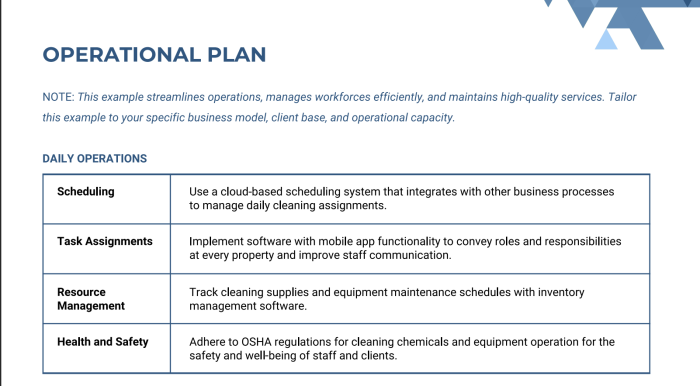
A clear understanding of operational expenses ensures you correctly price cleaning jobs and target realistic revenue goals.
Recurring expenses are costs you pay regularly to keep your business running. Ongoing expenditures include:
Employee payroll and benefits
Mortgage or rental payments
Vehicle insurance
Cleaning products and supplies
Equipment maintenance
Taxes
Technology subscriptions
Some expenses may be fixed, such as the mortgage payment, while others may be variable, such as the cost of cleaning products.
Follow a budget, use best-practice accounting procedures, and track expenses to make needed financial adjustments.
Aspire’s comprehensive business management software collects financials above the gross margin line and pushes them in a one-way data sync to your accounting platform so you have clean, accurate data to inform your business plan updates.
Financial projections and realism
Financial projections predict business revenue over a certain period. Data-backed financial plans drive better business decisions and help you plan for the future.
A startup cleaning business uses projected financial statements to determine future revenue and expenses. Industry and market analysis data can provide a starting point. In the case of an established cleaning business, use your historical data to project a percentage of financial growth.
To create a financial projection, you’ll need the following financial statements:
Income statement: An income statement, or profit and loss statement (P&L), shows your income and expenses. Your income statement should cover one year.
Cash flow statement: This statement projects all incoming and outgoing expenses for one year. A break-even analysis shows you how much revenue you need to break even with your expenses.
Balance sheet: This document lists business assets and liabilities and shows a summary of a business at present.
In financial projections, accuracy is key. You don’t want to inflate your numbers, fail to reach your goals, or underestimate and miss out on growth opportunities.
As your business continues to operate, it’s important to use the right software to capture accurate financial data to achieve financial objectives and increase the accuracy of future projections.
Aspire commercial cleaning business software integrates purchasing, invoicing, accounting, and payroll for full financial visibility. Robust reporting allows you to drill into sales, financials, job costs, and KPIs.
With real-time data, you gain deeper insight into business performance and can develop more effective business growth strategies.
Operations plan: Running a thriving cleaning company
A business operations plan outlines how your company will deliver high-quality service and achieve operational goals.
As you create an operations plan, involve your management team for ideas and input. After all, your managers are the ones who provide on-the-job oversight and remain accountable for operational goals.
An operations plan includes these elements:
Determine operational goals: Set business and departmental goals. For instance, you could set a goal to increase annual revenue by 20% or a sales goal of 10 new cleaning contracts monthly.
Create roles and job descriptions: Clearly define the roles and responsibilities of each position. This ensures accountability and the ability to measure performance.
Plan the how-tos: Detail business processes and workflows in every department so your team delivers consistent, efficient results. This includes investing in commercial cleaning business software to centralize data and streamline operations.
Track performance: Set KPIs to measure short-term goals and identify areas for improvement. Operational KPIs measure the performance of your operations, such as average contract amount, contract renewal conversion rate, closing percentage, and gross profit percentage by department.
Aspire provides user-based dashboards so every role can see the KPIs relevant to their short- and long-term goals. Having accurate, real-time information fuels responsive management, building ongoing growth momentum.
Commercial cleaning business owners who optimize operations experience the greatest profitability and growth. Aspire commercial cleaning business software provides seamless workflows in every area of business, including:
Scheduling
Crew management
Estimating
CRM
Job costing
Purchasing
Equipment and supply management
Reporting
Streamlined processes reduce waste, increase efficiency, and improve performance in your operations.
Set up your commercial cleaning business for success
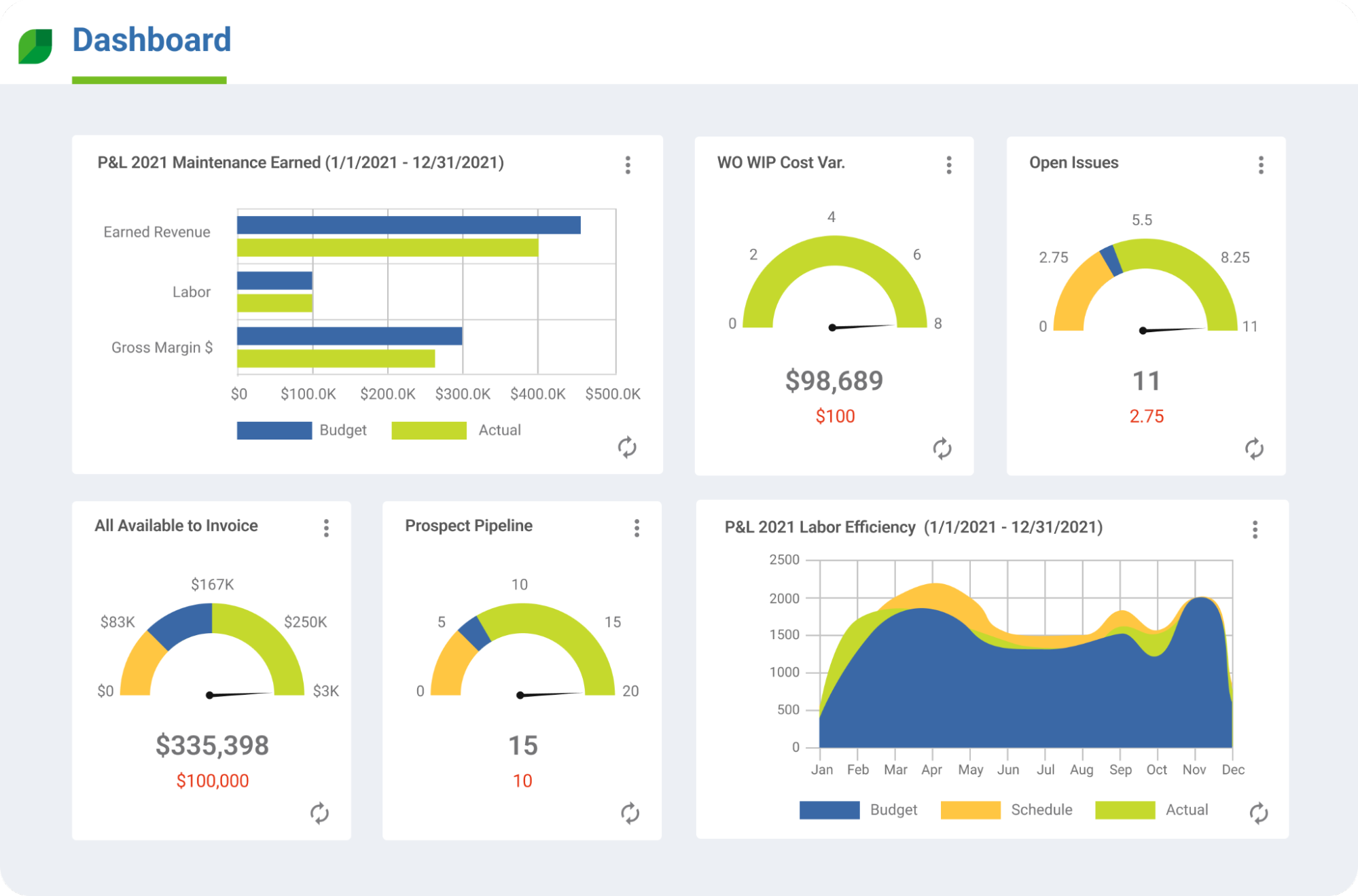
Creating a thorough commercial cleaning business plan sets the stage for business growth. But successful results rely on how well you execute your plan.
Aspire commercial cleaning business software provides industry-specific management tools to empower business owners to take control of operations. From simplified scheduling to accepting customer credit card payments online, Aspire’s advanced features give cleaning contractors full visibility into business operations and finances.
To get your business plan off the ground, implement the right tools to improve business and boost year-over-year growth.
Ready to see what Aspire can do for you?Request a demo to see Aspire features in action.

